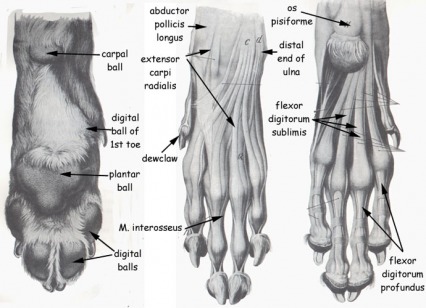Wolf Range
Eyes and Vision

Wolves are usually born with deep blue eyes which lighten and then gradually fade into the adult eye color over the next six to ten weeks. A mature Wolf's eyes are often amber/brown or gold, but also commonly come in hues of brown, gray, yellow, and green. It is interesting to note that puppies are born with blue eyes, while mature Wolves do not retain blue as an eye color. Huskies often have blue eyes, and because of this people think there must be blue eyed Wolves as well, but this isn't true. If you see a Wolf with blue eyes then he or she is likely a Wolf-hybrid and not a full-blooded Wolf.
A Wolf's eye sight is just about as good as that of a human being. However some experts believe that Wolves may be nearsighted because their eyes lack a foveal pit, an indentation in the retina which provides for focusing, especially on distant objects. Wolves have excellent peripheral vision and their eyes are optimized to detect motion. In addition, they have a very high ratio of rods (grayscale receptors) to cones (color receptors) in the retina; in fact, about 95% rods. This abundance of rods aids the Wolf in the ability to see at night. A Wolf's night vision is far superior to that of a human being.
Although little research has been done into a Wolf's ability to see color, it is believed that they may be partially color blind. Wolves have only red and blue photo receptors in their eyes, unlike humans, who have red, green, and blue photo receptors. Tests on domestic canines show that they may not be able to distinguish yellow from green or orange from red. Tests on Wolves, where red, blue, yellow, and green dyes were put onto clean snow, show that they often detect the red and yellow stains. This could be because they associate these colors with blood and urine and have little interest in the other colors. There is no conclusive evidence regarding the color vision abilities of Wolves, however. It is my personal belief that Wolves can see all of the colors, but only take an interest in those that might benefit them in some way.
Canines have a third eyelid (nictitans) which stretches across the eye and contains a gland which, along with glands in the ciliary body, acts to lubricate the eye. However, these tear glands excrete an oily substance rather than watery tears: Canines are not able to shed the moist tears of sorrow as humans do, but this doesn't mean they don't cry.
A Wolf's eye sight is just about as good as that of a human being. However some experts believe that Wolves may be nearsighted because their eyes lack a foveal pit, an indentation in the retina which provides for focusing, especially on distant objects. Wolves have excellent peripheral vision and their eyes are optimized to detect motion. In addition, they have a very high ratio of rods (grayscale receptors) to cones (color receptors) in the retina; in fact, about 95% rods. This abundance of rods aids the Wolf in the ability to see at night. A Wolf's night vision is far superior to that of a human being.
Although little research has been done into a Wolf's ability to see color, it is believed that they may be partially color blind. Wolves have only red and blue photo receptors in their eyes, unlike humans, who have red, green, and blue photo receptors. Tests on domestic canines show that they may not be able to distinguish yellow from green or orange from red. Tests on Wolves, where red, blue, yellow, and green dyes were put onto clean snow, show that they often detect the red and yellow stains. This could be because they associate these colors with blood and urine and have little interest in the other colors. There is no conclusive evidence regarding the color vision abilities of Wolves, however. It is my personal belief that Wolves can see all of the colors, but only take an interest in those that might benefit them in some way.
Canines have a third eyelid (nictitans) which stretches across the eye and contains a gland which, along with glands in the ciliary body, acts to lubricate the eye. However, these tear glands excrete an oily substance rather than watery tears: Canines are not able to shed the moist tears of sorrow as humans do, but this doesn't mean they don't cry.
Ears and Hearing
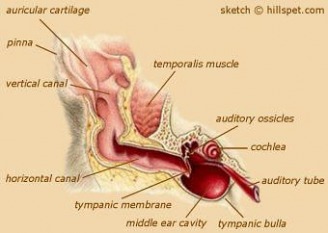
A Wolf's ears are triangle shaped and rounded across the top; they are much broader and shorter than coyote or fox ears. Wolves tend to have shorter/darker fur on the backside of the ear, with a lighter, somewhat longer fur along the inside.
Wolves are able fold their ears back against their head, move them side to side, and forward independently of each other. This range of motion assists the Wolf in detecting the direction of sound quite precisely. Wolves also use ear postures for communicating amongst themselves.
Hearing is a Wolf's second most developed sense. It is thought that domestic canines can hear sixteen times better than human beings. It is supposed that a Wolf's ability to hear is even better than this. Experts believe that Wolves may be able to hear frequencies far above the limits of human beings. The upper limit of human hearing is about 20 kHz, a Wolf's upper limit has been estimated at between 25 and 80 kHz. Wolves have been known to react to imitated Wolf howls from five kilometers (three miles) away. Some experts say that a Wolf can hear ten to sixteen kilometers (six to ten miles), depending on the density of trees and other obstacles between them and the source of the sound.
Wolves are able fold their ears back against their head, move them side to side, and forward independently of each other. This range of motion assists the Wolf in detecting the direction of sound quite precisely. Wolves also use ear postures for communicating amongst themselves.
Hearing is a Wolf's second most developed sense. It is thought that domestic canines can hear sixteen times better than human beings. It is supposed that a Wolf's ability to hear is even better than this. Experts believe that Wolves may be able to hear frequencies far above the limits of human beings. The upper limit of human hearing is about 20 kHz, a Wolf's upper limit has been estimated at between 25 and 80 kHz. Wolves have been known to react to imitated Wolf howls from five kilometers (three miles) away. Some experts say that a Wolf can hear ten to sixteen kilometers (six to ten miles), depending on the density of trees and other obstacles between them and the source of the sound.
Wolf Fur
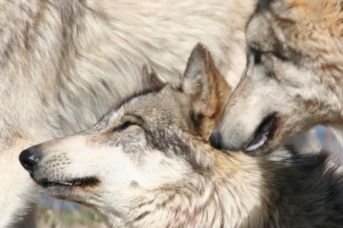
Wolves have bulky coats consisting of two layers. Their first layer is made up of tough guard hairs that repel water and dirt. Their second layer is a dense, water-resistant undercoat that insulates the wolf and keeps it warm. Their undercoat is shed in the form of large tufts of fur in late spring or early summer (with yearly variations). A wolf will often rub against objects such as rocks and branches to encourage the loose fur to fall out. Their undercoat is usually grey regardless of the outer coats appearance. Wolves have distinct winter and summer pelages (the hair or fur that covers the animal) that alternate in spring and autumn. Female wolves tend to keep their winter coats further into the spring than male wolves. North American wolves typically have longer, silkier fur than their Eurasian relatives.
The colour of the wolfs fur varies greatly, from grey to grey-brown, to white, red, brown and black. These colours tend to mix in many populations to form predominantly blended individuals, though it is not uncommon for an individual or an entire population of wolves to be entirely one colour (usually all black or all white). A multicolour coat lacks any clear pattern and tends to be lighter on the wolfs undersides. A wolfs fur colour sometimes corresponds with a wolf populations environment, for example, all-white wolves are much more common in areas with snow cover. Aging wolves acquire a greyish tint in their coats. The Grey Wolf and the Red Wolf tend to have interspersed flicks of yellowish colouring appearing through their base colour.
At birth, wolf pups tend to have darker fur and their eyes have blue irises that will change to a yellow-gold or orange colour when the pups are between 8 and 16 weeks old. Though extremely unusual, it is possible for an adult wolf to retain its blue-coloured irises.
information from: www.animalcorner.net
The colour of the wolfs fur varies greatly, from grey to grey-brown, to white, red, brown and black. These colours tend to mix in many populations to form predominantly blended individuals, though it is not uncommon for an individual or an entire population of wolves to be entirely one colour (usually all black or all white). A multicolour coat lacks any clear pattern and tends to be lighter on the wolfs undersides. A wolfs fur colour sometimes corresponds with a wolf populations environment, for example, all-white wolves are much more common in areas with snow cover. Aging wolves acquire a greyish tint in their coats. The Grey Wolf and the Red Wolf tend to have interspersed flicks of yellowish colouring appearing through their base colour.
At birth, wolf pups tend to have darker fur and their eyes have blue irises that will change to a yellow-gold or orange colour when the pups are between 8 and 16 weeks old. Though extremely unusual, it is possible for an adult wolf to retain its blue-coloured irises.
information from: www.animalcorner.net
Nose, Tongue, Taste, and Smell
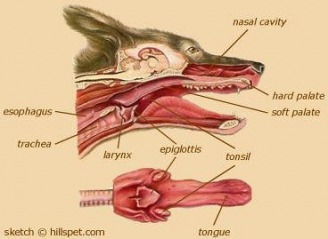
A Wolf's nose is composed dark or black, rubber-like, tissue at the end of the muzzle and above the lip, with a pair of nostrils leading to the nasal cavity which lie above the hard palate of the mouth. The nose is the only part of the canine body that "sweats," as there are no sweat glands in the skin. The nose gets wet and cold as the Wolf exercises in order to cool the blood flowing through the muzzle and facilitate a constant body temperature.
The sense of smell is a Wolf's most developed sense and greatest asset. A domestic canine's nasal cavity has about twenty-five times the number of olfactory receptors and fourteen times the scent receptive surface area of a human being. It has been suggested by experts that a Wolf may have twelve times the ability to detect odors of a domestic canine and a hundred times that ability of a human being.
The sense of smell plays a very important role in lupine life and society. Not only is it the means by which Wolves detect and locate pray, but it is instrumental in a variety of other tasks. A Wolf's body has scent glands (see the Scent Glands section) that tell a Wolf's health, mood, and identity to other Wolves. Upon meeting, Wolves will smell each other's muzzle, anus, and tail to make sure they know who the other Wolf is, and also learn details about health, mood, where the Wolf has been, and what she/he has been eating. Wolves use urination, called marking, to mark their territories so other Wolves may know they are crossing into another pack's land by smelling the marks.
A Wolf's tongue is long and quite soft. It is covered in hundreds of projections called papillae which aid in grooming and with tugging meat from bones. A Wolf also uses the tongue for licking up blood, drinking water, and during certain social rituals where tongue contact indicates respect and/or submissive behavior. The tongue is quite thick, but tapers to a thin tip that can be curved into a ladle-like form, making it especially useful for lapping up water.
It's difficult to know exactly what another animal is able to taste, but it is known that canines have taste receptors that permit them to know the sensations of sweet, salty, bitter, and acidic.
The sense of smell is a Wolf's most developed sense and greatest asset. A domestic canine's nasal cavity has about twenty-five times the number of olfactory receptors and fourteen times the scent receptive surface area of a human being. It has been suggested by experts that a Wolf may have twelve times the ability to detect odors of a domestic canine and a hundred times that ability of a human being.
The sense of smell plays a very important role in lupine life and society. Not only is it the means by which Wolves detect and locate pray, but it is instrumental in a variety of other tasks. A Wolf's body has scent glands (see the Scent Glands section) that tell a Wolf's health, mood, and identity to other Wolves. Upon meeting, Wolves will smell each other's muzzle, anus, and tail to make sure they know who the other Wolf is, and also learn details about health, mood, where the Wolf has been, and what she/he has been eating. Wolves use urination, called marking, to mark their territories so other Wolves may know they are crossing into another pack's land by smelling the marks.
A Wolf's tongue is long and quite soft. It is covered in hundreds of projections called papillae which aid in grooming and with tugging meat from bones. A Wolf also uses the tongue for licking up blood, drinking water, and during certain social rituals where tongue contact indicates respect and/or submissive behavior. The tongue is quite thick, but tapers to a thin tip that can be curved into a ladle-like form, making it especially useful for lapping up water.
It's difficult to know exactly what another animal is able to taste, but it is known that canines have taste receptors that permit them to know the sensations of sweet, salty, bitter, and acidic.
Teeth, Fangs, and Jaws
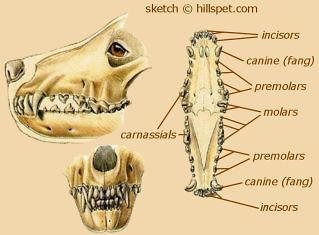
A Wolf has 42 teeth: the upper jaw has six incisors; for cutting flesh, two canines (also called fangs); for piercing into flesh and holding prey, eight premolars and four molars; for slicing and grinding. The lower jaw has six incisors, two canines, eight premolars, and six molars. The last premolars on the upper jaw and the first molars on the lower jaw are called the carnassial teeth; specialized for slicing through meat. The canines may reach a length of 5.7 centimeters (2.25 inches), which includes the area set within the jaws.
Experts have surmised that Wolves are capable of a jaw pressure of up to 105 kilograms per square centimeter (1,500 pounds per square inch). This is about twice the jaw pressure of a German shepherd.
Experts have surmised that Wolves are capable of a jaw pressure of up to 105 kilograms per square centimeter (1,500 pounds per square inch). This is about twice the jaw pressure of a German shepherd.
Paws, Legs, and Movement
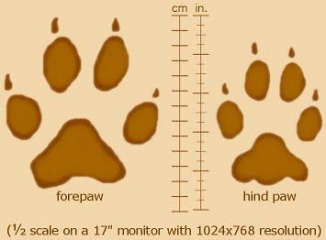
Wolves have long, strong legs and large paws; they are built for speed and agility. The forelegs appear pressed into the Wolf's narrow chest, with the elbow turned inward and the paws turned outward. This allows the Wolf's fore and hind legs to swing in a strait line so that the hind paw falls into the impression that the front paw left. Domestic canines generally leave the hind paw impression next to the forepaw impression. The Build of a Wolf's legs are ideal for fast, agile movement over all types of terrain, even deep snow. And the webbing between their toes makes Wolves excellent swimmers as well.
As with other canines, Wolves are digitigrade; meaning they bear their weight on their toes as they walk and not the entire sole of the foot. There are four toes on each hind paw, and five toes on each forepaw. However, one of the toes on the forepaw is used for clasping and doesn't touch the ground. Each toe has a calloused pad and a non-retractable claw. Also, each paw has a single large calloused heel pad. An adult Wolf's forepaw prints measure from about 11.4 to centimeters 12.7 (4� to 5 inches) in length and from about 9.5 to 11.4 centimeters (3� to 4� inches) in width, with their hind paws measuring 15 to 20% smaller then their forepaws.
As average gait of a Wolf is between 6.5 and 8 kilometers (4 and 5 miles) per hour. Wolves can maintain an average top speed of about 40 kilometers (25 miles) per hour over a distance of 3 kilometers (2 miles). A Wolf maintaining a speed of 56 kilometers (35 miles) per hour over 6 kilometers (4 miles) was reported by a Minnesota game warden in 1955. There have been other reports of Wolves running in excess of 56 kilometers (35 miles) miles per hour, but these are likely exceptional extremes. Wolves bound when they are in pursuit of large prey animals. L. David Mech reported that he witnessed Wolves bounding over 5 meters (16 feet) while in pursuit of moose. Wolves can keep up the chase for about twenty minutes, after which they tend to rest or sleep for at least ten to fifteen minutes before resuming activity.
It's not uncommon for a Wolf to travel 32 to 48 kilometers (20 to 30 miles) a day while hunting. Where food is scare Wolves have been recorded to have walked 190 kilometers (120 miles) searching for food in a single day. Wolves have a great capacity for long journeys. When dispersing from their pack, lone Wolves have been monitored traveling over 800 miles in search of new territory.
As with other canines, Wolves are digitigrade; meaning they bear their weight on their toes as they walk and not the entire sole of the foot. There are four toes on each hind paw, and five toes on each forepaw. However, one of the toes on the forepaw is used for clasping and doesn't touch the ground. Each toe has a calloused pad and a non-retractable claw. Also, each paw has a single large calloused heel pad. An adult Wolf's forepaw prints measure from about 11.4 to centimeters 12.7 (4� to 5 inches) in length and from about 9.5 to 11.4 centimeters (3� to 4� inches) in width, with their hind paws measuring 15 to 20% smaller then their forepaws.
As average gait of a Wolf is between 6.5 and 8 kilometers (4 and 5 miles) per hour. Wolves can maintain an average top speed of about 40 kilometers (25 miles) per hour over a distance of 3 kilometers (2 miles). A Wolf maintaining a speed of 56 kilometers (35 miles) per hour over 6 kilometers (4 miles) was reported by a Minnesota game warden in 1955. There have been other reports of Wolves running in excess of 56 kilometers (35 miles) miles per hour, but these are likely exceptional extremes. Wolves bound when they are in pursuit of large prey animals. L. David Mech reported that he witnessed Wolves bounding over 5 meters (16 feet) while in pursuit of moose. Wolves can keep up the chase for about twenty minutes, after which they tend to rest or sleep for at least ten to fifteen minutes before resuming activity.
It's not uncommon for a Wolf to travel 32 to 48 kilometers (20 to 30 miles) a day while hunting. Where food is scare Wolves have been recorded to have walked 190 kilometers (120 miles) searching for food in a single day. Wolves have a great capacity for long journeys. When dispersing from their pack, lone Wolves have been monitored traveling over 800 miles in search of new territory.
the pictures and the information are from an article by Wolf Howl Organization


